Introduction
Areca nut is being used in food and beverage, cosmetics, textiles and coir industries 1. India is the largest producer of Areca nuts in the world and ranks first in both area of cultivation (58%) and production (53%) of Areca nuts. Areca nut cultivation forms the major livelihood of farmers of costal and malnad parts of Karnataka as shown in the map (Fig.1) covering around 2.15 lakh hectors of land on and annual production of 12375 metric tons of areca2.
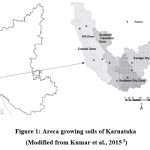 |
Figure 1: Areca growing soils of Karnataka (Modified from Kumar et al., 2015 3). |
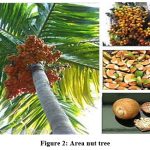 |
Figure 2: Area nut tree |
Areca nut tree belongs to a palm family Aceraceae. The tree can grow up to 30 meter high, which has adventitious root system and leaves are of paripinnate in structure and emerges from crown (Fig.2) . Humid tropic climate and loamy soil with uniformly distributed rainfalls are best suitable for high yields. It takes about six to seven years for a plantation to start yielding arecanuts. Areca nut takes 40 to 45 weeks to get fully ripe and then it has to be harvested and dried in the sun for about 40 to 45 days by spreading on the ground evenly as shown in the Figure 3.
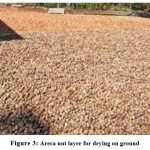 |
Figure 3: Areca nut layer for drying on ground |
The process of manual collection of arecanut from ground during drying, is time consuming and laborious process. One person must grab the areca nut from ground using cane baskets and other person to hold gunny bag for filling areca. Owing to the uncertain climatic condition, increased labor of cost, shortage of labors, farmers are constantly in search for alternative means to complete the tasks. The scope identified in this sector areca farming for modernization identified from the rigorous field visits is the areca nut collecting machine.
Jaganath Patter et al. fabricated area nut collecting machine which was modelled through CAD packages (Fig. 4). However, the machine did not perform satisfactorily due to the design drawbacks such as high angle of inclination of elevator and absence of mechanism for feeding nuts from ground to elevator buckets.
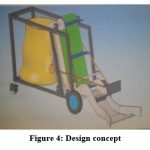 |
Figure 4: Design concept |
Kannur et al. (2017)6 worked on the fabrication of areca nut collecting machine which has a belt conveyor mechanism as shown in Fig. 5. Following drawbacks have been observed in their design. No mechanism for bagging, need of direct power supply for the working of machine, and no feeder mechanism for collecting areca from the ground. Hence, the machine needed human support to feed arecanut from ground.
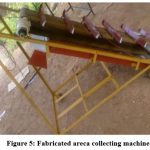 |
Figure 5: Fabricated areca collecting machine |
Daniyan et al. (2016)8 designed the belt conveyor, roller diameter, belt power and tensions, pulley diameter and shaft design for lime stone conveyor application. This work generated design data for industrial uses. Nasif et al. (2017)9 presented the design of conveyor systems including mechanical and electrical components with a special emphasis to safety requirements of conveyor systems. Akshay et al. (2017)10 presented the design of a conveyor system for the oil packing industry. Programmable Logic Control was used along with necessary sensors which can detect the weight of the oil bottle. Gupta et al. (2013)11 reviewed the material handling equipment (belts, trolly, gantry, gib, Robots, AVG) and their potential applications in moving components from one location to another. Roberts et al. (2007)12 worked on design of belt conveyor system for bulk solid transportation of mineral ore. Developed a simulation test ring and studied the belt tension, belt vibrations and also incorporated belt cleaner system to remove the adhesion of bulk materials . Heragu et al (2015)13 Reviewed on various material handling equipment’s such as AGVS, Robots, trucks, palletizers , conveyor systems and also choice of right material handling system based on load for optimum operation coasts . Kay, M.G. (2012)14 detailed the design aspects of material handling systems (MHS) including fabrication, assembly and tailoring the design modifications to the customized requirements. Sivakumar et al. (2016)15 designed a prototype with an electric motor, shafts and frames. Aluminium, due to its low density, was suggested for frames. The lifting capacity of the system was estimated as 2 to 3 kg. Several machines are being developed to help farmers. Areca nut collecting and bagging machines are new additions.
Components and Working Principle of Collecting Machine
The design methodology of the proposed areca nut collecting machine is very basic and simple. The Unidirectional motor shaft is coupled to the gear box which drives the rollers of the conveyor system. The motor is powered by DC battery and the voltage regulation is done through the potentiometer. Table 1summarizes the specification details.
Table 1: Specification details of components used
| Component | Specification |
| Chassis | 1. Type/shape: Right-Angled triangle
2. Material: GI steel 3. Tubing: Square 1.5 inch, thickness 3 mm 4. Kerb weight (approx): 35 kg |
| Conveyor | 1. Type: Sandwich – conveyor
2. Sandwich clearance = 1.25 inch 3. Dimensions of belt (LxB) = 3.8*0.65 m |
| Drive | 1. Geared DC Motor
2. Driver motor RPM: 1800 3. Reduced motor RPM: 50 4. Rated Torque: 8.5 kg-cm 5. Gearbox Dimensions: 30×37 (LxW) mm |
| Support & Mobility | 1. Type: Road-wheels (tube-tyre)
2. Wheel size: 8 inch |
| Battery | 1. Type: DC, Lead-acid
2. Power rating: 24V, 12 A 3. Rechargeable: yes |
| Motor | 1. Type: Geared DC Motor (Grade B)
2. Rated Voltage: 24 V 3. Amperage: 9 A |
| Potentiometer | 12 A PWM DC Motor Speed Regulator (12V) |
The mechanical system of areca collector consists of chassis is divided into two parts i.e. base part and hypotenuse part. Base part of the chassis is supported by 4 free road-wheels for mobility. On base there is housing for weighing scale at the rear end, and to the front there are hinge brackets for feeder ramp supports. The feeder ramp is controlled by a steel cable line to either elevate or lower it by providing a brake lever or cycle at the steering handle. The Sandwich-conveyor is mounted in line with the hypotenuse part of the chassis at a 24 degree inclination. Beneath the top end roller of conveyor assembly supports for gunny bags are provided. An anti-fly-off shield is also mounted in between the steering handle neck and gunny bag hooks. Only the top roller of the conveyor assembly is driven by a gear box which is coupled with a motor. The 3D model was created using solid edge software and is shown in Fig. 6. Two-dimensional drawing of the same is presented in Fig. 7.
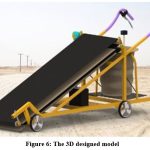 |
Figure 6: The 3D designed model |
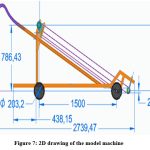 |
Figure 7: 2D drawing of the model machine. |
Analysis and Result
Finite Element Analysis Simulation of components of areca collecting machine involves check for stability due to the forces acting on the machine components, analyzed using Solid Edge(V18) tool.
(a) Analysis for stresses on vertical elements
F1 = Load of upper end of conveyor assembly
F2 = Load of electrical components
F3 = Load of filled gunny bag
F4 = Load of lower end of conveyor assembly
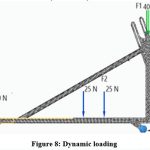 |
Figure 8: Dynamic loading |
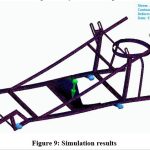 |
Figure 9: Simulation results |
(b) Analysis for crumpling of feeder ramp due to its impact with uneven earth or stone
Due to human pushcart moves freely which creates an acceleration. In uneven ground ramp edge may collide with it and result in crumpling. Assumed impact load 5000 N.
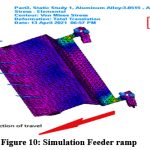 |
Figure 10: Simulation Feeder ramp. |
(c) Analysis for sagging of lower conveyor due to weight of Areca nuts
Conveyor belt material: Silicon
Dimensions of belt in mm (LxB) = 1.9 x 0.65 m
Approximate weight of green areca in N = 100
Belt thickness in mm = 6
Deflection in mm = 2
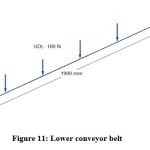 |
Figure 11: Lower conveyor belt |
Table 2: Optimizations carried out based on analysis
| Components | Objective of analysis | Constraints | Material | Result | Optimization |
| Feeder Ramp | Crumpling of Feeder ramp against ground | 1. Impact load of 5000N on front edge
2. Hinged supports |
Al alloy | Deformation found near hinged sections with stress 3.6 MPa | Thickness of sheet was increased to 6 mm from 4mm with additional ribs |
| Conveyor | Sagging | Fixed at both end points i.e., roller ends | Silicone | Deflection of 3 mm | Provided with support plates |
| Chassis | Stress on vertical columns | Pay load of 100 kg | GI Steel | Stress of 0.99 MPa | Working stress 0.99 MPa is within 3.96 MPa which is the maximum stress. Hence structure supports the applied load without deformation |
Bagging Efficiency
The bagging efficiency is calculated as number of areca nuts can be drawn per revolution of belt conveyor. The dimension of belt conveyor for one revolution = 800×600 =4800000 mm2, the average fully grown areca diameter is 50 mm the bagging efficiency turns out to be 900 areca per revolution.
Conclusion
The areca nut collecting machine is modelled to collect areca nuts from the ground and then place them on collecting bag. The proposed machine is expected to yield the benefits by reduced time and efforts for collecting areca nuts and subsequent packing. It can mitigate labor shortage issue to some extent. The utilization of this machine can also be extended for other similar purposes.
The analysis suggests the increase in the thickness of the feeder ramp along with the provision of ribs and providing a support plate for the conveyor belt. Further, this analysis reveals following inferences:
The machine can take load up to 100 kg
The optimum thicknesses for the chassis frame and feeder ramp sheet are 3 mm and 6 mm respectively.
Acknowledgment
The authors acknowledge the assistance rendered by group of fellow students in bringing this work. Thanks are also due to Karnataka State Council for Science and Technology (KSCST) for providing financial assistance for this work.
Conflict of Interest
There is no conflict of interest.
Funding Sources
There is no funding Source.
References
- Anonymous. The Totgar’s Co-Operative society Ltd. Sirsi. 2022; available at: https://www.tssindia.in/index.php/other1/about-arecanut-menu/uses-of-areca-and-components
- Ramappa, D. R. Economics of Areca nut Cultivation in Karnataka, a Case Study of Shivamogga District. IOSR Journal of Agriculture and Veterinary Science. 2013; 3.DOI:50-59. 10.9790/2380-0315059.
CrossRef - Kumar D.M., Binny G., Dhananjay. Delineation and Mapping of Micronutrients Status through GIS Technique for Arecanut Gardens under Traditional and Non-Traditional Areas of Karnataka. International Journal of Agricultural Sciences and Research. 2015; 10, 3281-3291. DOI:181-188.10.24247/ijasrjun201722.
- Coppola, M., Mondola, R., Oliva, F., and Picci, R. L. Chapter-79: Areca Alkaloids and Schizophrenia. Neuropathology of Drug Addictions and Substance Misuse, Academic Press. 2016; 3, 794-802. DOI: 10.1016/B978-0-12-800634-4.00079-2
CrossRef - Patter, J., Mehath, A. Design and Fabrication of Areca Nut Collecting and Bagging Machine. International Journal of Engineering Research and Technology. 2015; 17(3): 1-7. ISSN:2278-0181
- Kunnur, S., Kulkarni, B., Ganiger, P. S. and Shetty, R. Design and Fabrication of Areca Nut Collecting and Bagging Machines. International Journal for Research & Development in Technology, 2017; 7(3): 648-653.
- Kumar, N.K, Nithin, P.R., Rodriges, O.T. Arecanut Collecting Machine by Belt Conveyor Machine. International Journal of Research in Engineering and Technology. 2016; 5(9): 34-36. ISSN:2319-1163.
CrossRef - Daniyan, I.A., Adeodu, A.O., and Dada, O.M. Design of a Material Handling Equipment: Belt Conveyor System for Crushed Limestone Using 3 roll idlers. Journal of Advancement in Engineering and Technology. 2014; 1 (1): 2348-2931.
CrossRef - Khan, N.H., Sarkar, D.K., Siddique, A., Rahman, M., and Chakraborty, S. Fabrication of a Conveyor Belt with Object Sorting and Counting Facility. International Journal of Advancements in Research & Technology. 2017; 6(5): 60-64. ISSN 2278-7763
- Akshay K.N., Deshmukh, M.J. A Review of Improved Automated Conveyor with Auto Separated System for Oil Packaging Industry International Journal of Research in Advent Technology. 2017; 4(5): 1245-1251. E-ISSN: 2321-9637
- Gupta, V., Bansal, R., and Goel, V.K. A Review on Material Handling Equipment and Their Selection for Potential Applications. Transport, 2013; 2(1): 51-54.
CrossRef - Roberts, A. W., and Harrison, A. Recent research developments in belt conveyor technology. International journal paper Australia. 2007; Corpus ID: 160023887
- Heragu, S.S., and Banu, E. Materials handling system design. M. Kutz, Mechanical Engineers’ Handbook, Manufacturing and Management 2015: 497-513.
CrossRef - Kay, M.G. Material handling equipment. Fitts Dept. of Industrial and Systems Engineering North Carolina State University 65. 2012.https://people.engr.ncsu.edu/kay/Material_Handling_Equipment.pdf
- Sivakumar, N., K. Thamaraikannan, R., Kalaiyarasan, S., Veerakumar, and Vijay, A. Design and Fabrication of Industrial Conveyor Using Crank Mechanism.International Research Journal of Engineering and Technology (IRJET). 2016; 3(4): 2868-2879.

